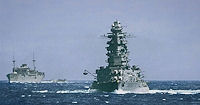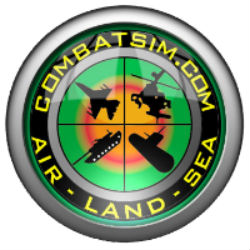 The Japanese Battleship Fleet in WWII
The Japanese Battleship Fleet in WWII
By John Dudek @ The Wargamer
Location: Somewhere in the Formosa Strait off the coast of Formosa (Taiwan) and the Pescadores Islands.
Time and Date: Twenty minutes after midnight on the overcast night of 21 November 1944 …
Submarine USS Sealion’s Skipper, Lt. Commander Eli Reich, stands on his surfaced submarine’s open bridge hoping to fire his torpedoes at a column of three Japanese battleships and escorts located miles ahead of him. His submarine is running in hot pursuit at full flank speed attempting to make an “end run” in order to get ahead of the Japanese warships and gain an optimum firing position as soon as the column comes to bear. The three battleships, IJN Kongo, Nagato and Yamato and the heavy cruiser Yahagi astern are moving at 16 knots on a steady course while not zigzagging. Three destroyer escorts flank both sides of the Japanese column of warships. Three hours later, as the seas and winds continue to rise and freshen, Reich turns his submarine directly at the column and fires all six of his bow torpedo tubes at the lead battleship. He then puts his submarine’s helm hard over in order to come about and bring his stern tubes to bear. He fires three stern tubes at the third ship in the column. At 0301 hours Reich sees three flashing torpedo hits strike the Kongo, sending towering waterspouts skyward. Three minutes later a much larger flashing thunderclap explosion is seen on the opposing, far distant side of the column as the Pearl Harbor veteran destroyer Urakaze runs afoul of several of Sealion’s torpedoes. She blows up and sinks immediately with all hands still aboard. Battleship searchlights snap on, probing the dark skies above with blinding fingers of brilliant light as their anti aircraft guns open fire, sending bright strings of tracer fire skyward in a vain search for non-existent enemy aircraft. For the stricken Kongo, one torpedo has struck its port bow in the anchor chain locker, ripping a major gash in her bow. The remaining torpedoes hit her port side amidships beneath the number 2 smokestack, flooding two of the boiler rooms. Nonetheless, Kongo is still able to continue steaming along with her escorting battleships, which are now zigzagging at 16 knots. However, her list to port is slowly beginning to increase. As the seas and winds increase, Reich orders Sealion’s engine room to go to full emergency overload speed in order to catch up and pass ahead of the Japanese column of ships to again attain another attack position on them. He keeps up the chase on the surface for the next two hours as Sealion begins taking on water in its engine room from huge waves now breaking over its open bridge and into its main induction valve. For the Kongo the constant pounding of the heavy waves and high rate of speed is beginning to tell on the damaged old battleship. In spite of her damage control crew’s constant shoring up and patching of the gash in the ship’s bow, the rate of flooding continues. As the damage to her torn bow increases, her list to port also grows. Kongo’s captain has no choice but to slow the battleship down to 11 knots as the remaining escorting warships move away and continue on their base course. At 0512 hours Reich slows his submarine to give his overburdened diesel engines a rest as he reaches attack position on the Kongo, who is slowing down even further. Sealion’s radar now shows the Kongo at a dead stop at a range of 17,000 yards, but her radar image seems to be shrinking and getting ever smaller with every passing second. Suddenly, a brilliant explosion lights up the darkened skies above the South China Sea, bathing the Sealion’s bridge in an unearthly light as the Kongo’s ammunition magazines detonate, sending her to the bottom. Kongo is the only Japanese battleship sunk by a submarine in WWII and the last battleship ever to be sunk by a submarine.

